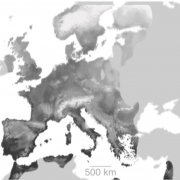On bioRxiv: Genomics of climate change adaptation
A map of climate change-driven natural selection in Arabidopsis thaliana
Exposito-Alonso, M., et al. doi: https://doi.org/10.1101/321133
Through the lens of evolution, climate change is a directional selection acting on populations, forcing them to change and adapt, or face extinction. We studied climate-driven selection at the genetic level by measuring fitness of 517 Arabidopsis thaliana lines grown in rainfall-manipulation experiments in Spain and Germany. Natural selection in the hot-dry Mediterranean location was the strongest, killing 63% of the lines and significantly changing the frequency of about 5% of all genome-wide variants. Rainfall treatment dictated the direction and magnitude of selection: variants that increased in frequency in a low-rainfall environment, decreased in frequency under high rainfall, and vice versa. A significant proportion of this selection was predictable from the annotation of variants and from the climate in the areas where different variants are found (R2=29-52%). Extrapolating our predictions to other areas of the species range suggested that selection driven by local climate would be strongest in the Mediterranean and Western Siberia — the edge of the species’ environmental limits — and weakest in Central Europe. With rapidly increasing droughts and rising temperatures in Europe, we forecast a wave of directional selection moving North, consequently decimating and causing a genetic turnover of some native A. thaliana populations.




